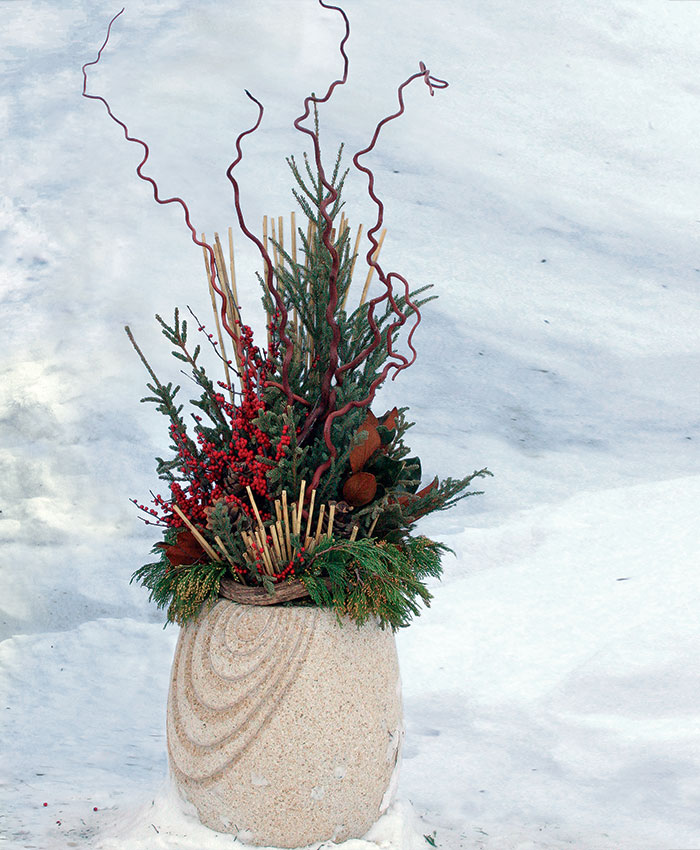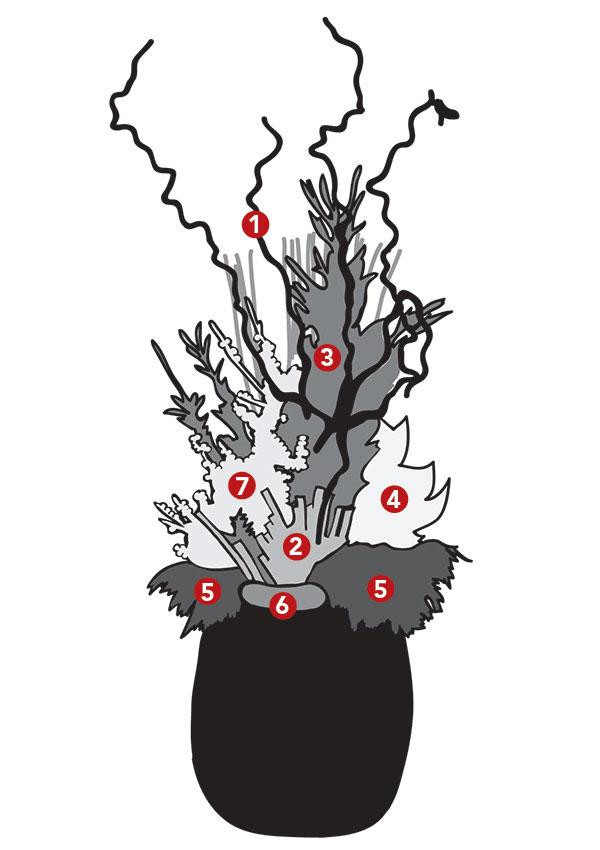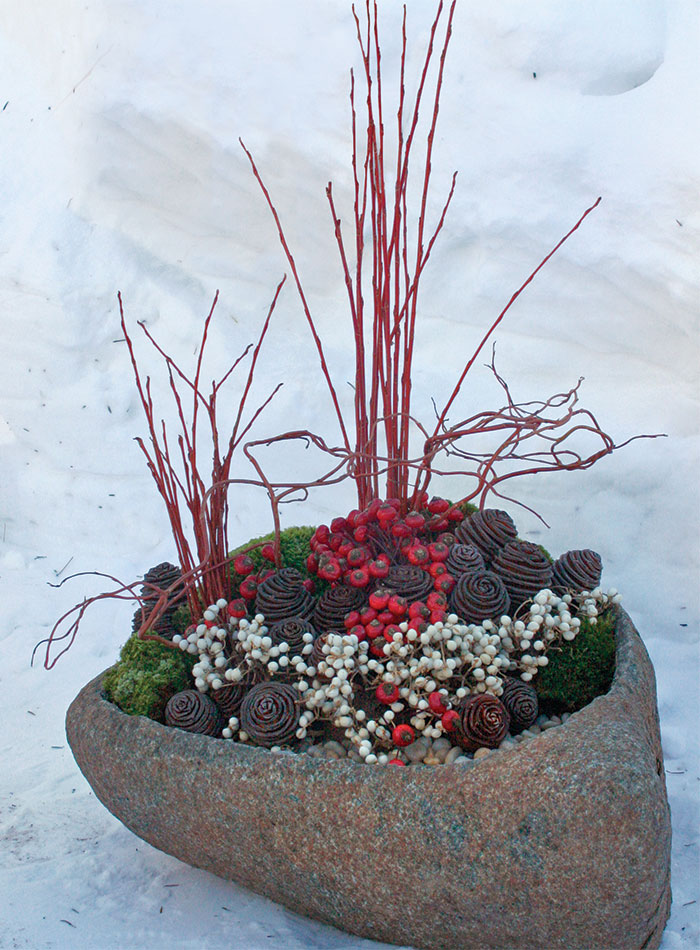6 Winter Container Ideas
When temperatures drop, get creative with cuttings and cold-hardy plants

If you’re striving for a garden with four-season appeal, don’t overlook your pots. Instead of retiring them for winter, fill them with an eye-catching combo of cold-hardy plants and cuttings. The extra textures and color will instantly brighten your garden’s dreariest season.
Evergreen boughs, interesting pods and cones, and colorful stems and berries are just some of the botanical materials you can weave into a container design. If you are fortunate enough to live in a warm part of the country, living plants are also an option. In regions where freezing temperatures are the norm, gardeners should be aware that the living selections available to them, such as conifers and hardy boxwood, will contribute to container aesthetics but may not survive winter; extreme temperature changes are often too harsh for their sensitive roots.
Location aside, nature provides ample options for wintry designs, as do garden centers and craft stores. Arrange combos using the same principles that apply to warm-season plantings, and your winter containers will be equally spectacular.
Reusable materials save time and money
If a material looks good and stands up to winter weather, why not reuse it from year to year? The reusable red bamboo poles in this pot offer a strong vertical accent, while living variegated boxwood provides more verticality and a striking backdrop.
Tall, bold gestures such as these are especially important in winter designs. People aren’t as likely to stop and linger when the weather is blustery, so designs need to read well from a distance. For this container, I wrapped dried magnolia leaves around African knobs (available at dried-flower retailers). Reconstructing natural materials and arranging them in clusters is another great way to make designs pop.
Living plants
1. Variegated boxwood (Buxus sempervirens ‘Variegata’, USDA Hardiness Zones 6–8)
Materials
2. Stained red bamboo poles
3. African knobs
4. Southern magnolia
5. Noble-fir boughs
Upping diversity spices up small containers
As a rule, more variety equals more impact. When designing small pots, use this to your advantage. Although there is a plethora of textures in this combination, similar forms unify them. Moss-covered orbs, poppy pods, and African knobs dot the horizontal plane, while cinnamon sticks, pheasant feathers, and whitewashed cacao stems add height.
The simple vintage wooden rice bucket grounds the combo. In cold climates, keep wooden containers out of the elements as wood cracks after repeated freezing and thawing.
Materials
1. Manzanita branches
2. Pheasant feathers
3. Whitewashed cacao stems
4. Cinnamon sticks
5. Preserved salal
6. Incense cedar
7. Poppy pods
8. Banana sticks
9. Sugar-pine cones
10. Moss-covered orbs
11. African knobs
12. Skeletonized leaves
Enhance your winter designs with unique containers
Look to the colorful glazes and decorative etchings on pots as a source of inspiration. The detailed carving on this container draws the eye up to the planting, while the mahogany-stained kuwa stems and black-spruce boughs continue the progression up and out.
Luckily, creating winter containers doesn’t have to mean gardening in frigid temperatures. For this container, I filled a plastic grower’s pot with potting soil and arranged the planting indoors. Once I finished the design, I brought it outside and slipped it into my decorative container.
This durable granite pot won’t crack in winter, but buyers beware: Once you put it in place, you won’t be able to move it until spring thaw.
Materials
1. Mahogany-stained kuwa stems
2. Reed bamboo
3. Black-spruce boughs
4. Southern magnolia
5. Incense cedar
6. Driftwood
7. Winterberry
Convert birdbaths into pots for an extra pop of color
This winter arrangement relies exclusively on nonliving materials. Finding complementary shapes and colors is key. Rose hips cascade over the top and between African knobs. Mood moss provides a soft contrast to the browns and reds in the container, while tallowberry creates a bright white ground cover. These soft shapes are punctuated with wispy spikes of flame willow and scarlet curls willow.
This granite wabi basin is one of my favorite winter containers because of its multifunctional use throughout the year. In summer it collects rainwater for birds and wildlife, and in winter its unique shape enhances any cold-season planting. Consider adding dried fruit to your designs so that they can double as a food source for birds.
Materials
1. Flame willow
2. Scarlet curls willow
3. African knobs
4. Rose hips
5. Mood moss
6. Tallowberry
7. Pea gravel
Revisit a traditional design to add a dramatic punch
Instead of potting up a pyramid-shaped conifer, give this centuries-old design a try. A Biedermeier is a conical arrangement composed of concentric rings. Although this design is not common in modern times, it is a fun way to combine many different materials or alternate a select few.
In this container, every ring has its place. Norway-pine boughs and Jeffrey-pine cones provide a solid base, while winterberry provides a sense of movement. Dried oranges pick up the color of the container, while dried pomegranates echo the form of the oranges.
To make the cone base, fill a metal obelisk with floral foam. Push dried leaves, fruit, and boughs directly into the foam. The copper pot used here nicely reflects sunlight and light bouncing off snow. It is also lightweight, durable, and resistant to damage from freeze/thaw cycles.
Materials
1. Norway-pine boughs
2. Jeffrey-pine cones
3. Winterberry
4. Southern magnolia
5. Dried oranges
6. Noble-fir boughs
7. Dried pomegranates
8. Norway-spruce cones
9. Pepper-berry tips
10. White pine
11. Murii cones
12. Orange winterberry
13. Weeping-willow branches
14. Variegated boxwood
Unexpected living plants give pots a twist
You may prefer all living material during the growing season, but winter is an opportune time to mix living plants with nonliving objects. In warm climates, hardy succulents, such as agave, make an unexpected addition to winter plantings. Lemon cypress adds a soft, vertical touch, while yellow-twig dogwood offers a hard edge and rosemary supplies subtle movement. Keep watering these living plants until the ground freezes.
Round glass balls provide contrast to the sharp, spiky forms in this arrangement. The rustic ceramic bowl complements the surrounding cool colors of winter and, with proper care, holds up well throughout winter. Northern gardeners might consider using cut dogwood stems and enjoying this arrangement inside.
Living plants
1. Lemon cypress (Cupressus macrocarpa ‘Goldcrest’, Zones 7–11)
2. Yellow-twig dogwood (Cornus sericea ‘Flaviramea’, Zones 3–8)
3. Rosemary (Rosmarinus officinalis, Zones 8–11)
4. Agave (Agave sp., Zones 7–11)
Materials
5. Jeffrey-pine cones
6. Glass orbs
7. Reindeer moss
8. Mood moss
Scott Endres is co-owner of Tangletown Gardens, a garden center and landscape-design firm in Minneapolis.


















Comments
Log in or create an account to post a comment.
Sign up Log in